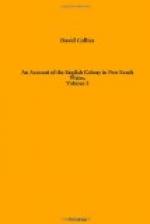A great smoke that arose at the back of one of the bights showed the main to be inhabited; but they could not suppose the people of this place to be furnished with canoes, when those of Adventure Bay, in their neighbourhood, were unprovided with them. Nothing, therefore, was left to their choice, but to allow that they might transport themselves over, either upon logs of wood, or by swimming across: and, as the most probable reward of such an exertion would be the capture of birds, whilst breeding, or the seizure of their eggs, the utility of spreading fires in facilitating such operations is obvious.
The south cape may be easily distinguished from any other projection in its vicinity. Besides being the southernmost, it is a promontory making like a foreland, and sloping very gradually as it runs towards the sea, where it ends in a perpendicular cliff.
About sunset the fresh NW wind died away suddenly; and a strong squall from the westward, with thunder, lightning, and heavy rain, soon carried them round the south cape, and, by dark, brought them off what was formerly called Storm Bay, where they hauled to the wind with the sloop’s head up the bay, intending, in the morning, to proceed by this Storm Bay passage into the Derwent river.
The night was squally, and by day light the next morning (the 14th), it was found that the vessel had drifted across the mouth of Storm Bay, or more properly Storm Bay Passage. Tasman’s Head, its eastern point, bore NE distant three miles. Being too far to leeward to fetch up the passage, and the gale continuing, they bore away round Tasman’s Head, and hauled up along shore for Adventure Bay.
Nothing remarkable was observed about Tasman’s Head, except two small islands lying off it, at the distance of half or three quarters of a mile; and close to them were the two conical basaltic rocks named by Captain Furneaux the Friars. The vegetation upon the inner most of the two small islands had been burnt in a manner similar to that on the De Witt’s isles. If it were possible to account for those fires in any other way than by the agency of man, it would be more satisfactory, than to suppose that people, always believed to be without canoes, had crossed over from a rather steep and rocky head, to an island equally rocky, but more steep.
Having passed Fluted Cape, a fine piece of basalt, and Penguin island, they fetched up under Cape Frederick Henry, the north point of Adventure Bay; but, as the wind blew strong directly off it, and the sloop was light and leewardly, they bore away round the Cape Frederick Henry, hauling upon the north side of it into the bay of that name, purposing to go into the Derwent river, discovered a few years since by Mr. Hayes, master of the ship Duke, of Bengal: but, finding that they were likely to lose ground by tacking, they stood into Henshaw’s bay (so named by Hayes), and were greatly surprised to find that, instead of its being a mere shallow bight, as laid down in Mr. Hayes’s chart, it extended many miles to the northward. The whole now bears the name of Frederick Henry Bay; that given by Hayes is lost. In this very extensive bay they remained a week, traversing and measuring various parts of its shores.




